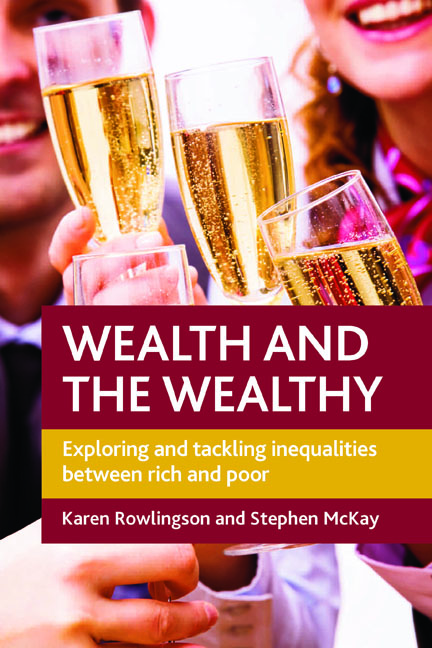Book contents
- Frontmatter
- Dedication
- Contents
- List of tables and figures
- Acknowledgements
- About the authors
- Introduction
- one Why wealth matters
- two Why the wealthy matter
- three What is wealth and who are the wealthy?
- four The distribution of wealth
- five The rich, the richer and the richest
- six Towards a comprehensive policy on assets
- seven Social policy and the wealthy
- Conclusions
- References
- Index
four - The distribution of wealth
Published online by Cambridge University Press: 01 September 2022
- Frontmatter
- Dedication
- Contents
- List of tables and figures
- Acknowledgements
- About the authors
- Introduction
- one Why wealth matters
- two Why the wealthy matter
- three What is wealth and who are the wealthy?
- four The distribution of wealth
- five The rich, the richer and the richest
- six Towards a comprehensive policy on assets
- seven Social policy and the wealthy
- Conclusions
- References
- Index
Summary
Introduction
There is a very high level of wealth inequality in Britain today, far higher even than the level of income inequality. This chapter presents analysis of the distribution of wealth using a range of sources of data, such as the Wealth and Assets Survey (WAS), Family Resources Survey (FRS) and Her Majesty's Revenue and Customs (HMRC) (formerly the Inland Revenue) data from people's estates. It compares the distribution of wealth with the distribution of income and then looks at particular types of wealth: financial savings, private pension wealth, property wealth and physical wealth. The analysis then considers the distribution of wealth by different groups in the population, for example, by age. Age is particularly important because the ‘lifecycle model’ suggests that some degree of wealth inequality is due to the fact that younger people will inevitably have had less time to accumulate wealth than older age groups. This chapter also looks at the distribution of assets among black and minority ethnic (BME) groups as well as different faith groups and social classes. Gender divisions are also considered, alongside a discussion of the within-household distribution of assets. Finally, the chapter analyses the role of inheritance and lifetime gifts in relation to intergenerational wealth inequality.
The distribution of wealth
The distribution of wealth is even more unequal than the distribution of income. For example, our analysis of the WAS 2006–08 shows that:
• the bottom 30 per cent in 2006–08 owned only 1 per cent of wealth;
• the top 10 per cent owned 44 per cent.
If we turn to income, our analysis of the Households Below Average Income (HBAI) 2007/08 dataset shows that:
• the bottom 10 per cent of the population received only 1 per cent of income;
• the top 10 per cent received 31 per cent.
Figure 4.1 illustrates this point further by dividing the population into deciles (tenths of the population). Shares of both income and wealth increase as we move up the deciles, with the top decile (the richest tenth of the population) having a particularly high share compared with other groups. The figure clearly illustrates that much higher level of wealth inequality compared with income inequality as the bottom three deciles (30 per cent) have virtually no wealth at all, and the top 10 per cent have 44 per cent.
- Type
- Chapter
- Information
- Wealth and the WealthyExploring and Tackling Inequalities between Rich and Poor, pp. 81 - 114Publisher: Bristol University PressPrint publication year: 2011

